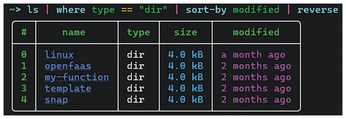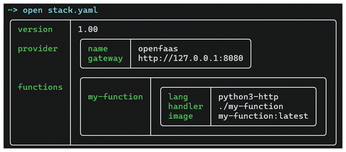A data-oriented shell
Filesystem Data as Tables
The ls command in Nushell returns a table of files with columns such as name, type, size, and modified timestamp, rather than a simple text listing. This means you can query it directly. For example, you can list directories in the current folder sorted by last modified time (as shown in Figure 3) with
ls | where type == "dir" | sort-by modified | reverse

System Information as Structured Data
Commands such as ps (process list) and sys (system info) are built into Nushell and return structured data as well. For instance, ps gives you a table of running processes (with columns for PID, name, CPU, memory, etc.). You could find the top memory-consuming process (see Figure 4) with
ps | sort-by mem | last 1

Opening and Parsing Structured Files
Nushell's open command is a powerful way to bring data from files (or URLs) into Nushell's pipeline. It auto-detects file types including JSON, CSV, TOML, YAML, XML, Excel, SQLite, and more and parses them into tables or records [2]. For example, the table in Figure 5 is generated with
open stack.yaml

Buy this article as PDF
(incl. VAT)
Buy Linux Magazine
Subscribe to our Linux Newsletters
Find Linux and Open Source Jobs
Subscribe to our ADMIN Newsletters
Support Our Work
Linux Magazine content is made possible with support from readers like you. Please consider contributing when you’ve found an article to be beneficial.

News
-
AerynOS Alpha Release Available
With a choice of several desktop environments, AerynOS 2025.08 is almost ready to be your next operating system.
-
AUR Repository Still Under DDoS Attack
Arch User Repository continues to be under a DDoS attack that has been going on for more than two weeks.
-
RingReaper Malware Poses Danger to Linux Systems
A new kind of malware exploits modern Linux kernels for I/O operations.
-
Happy Birthday, Linux
On August 25, Linux officially turns 34.
-
VirtualBox 7.2 Has Arrived
With early support for Linux kernel 6.17 and other new additions, VirtualBox 7.2 is a must-update for users.
-
Linux Mint 22.2 Beta Available for Testing
Some interesting new additions and improvements are coming to Linux Mint. Check out the Linux Mint 22.2 Beta to give it a test run.
-
Debian 13.0 Officially Released
After two years of development, the latest iteration of Debian is now available with plenty of under-the-hood improvements.
-
Upcoming Changes for MXLinux
MXLinux 25 has plenty in store to please all types of users.
-
A New Linux AI Assistant in Town
Newelle, a Linux AI assistant, works with different LLMs and includes document parsing and profiles.
-
Linux Kernel 6.16 Released with Minor Fixes
The latest Linux kernel doesn't really include any big-ticket features, just a lot of lines of code.

